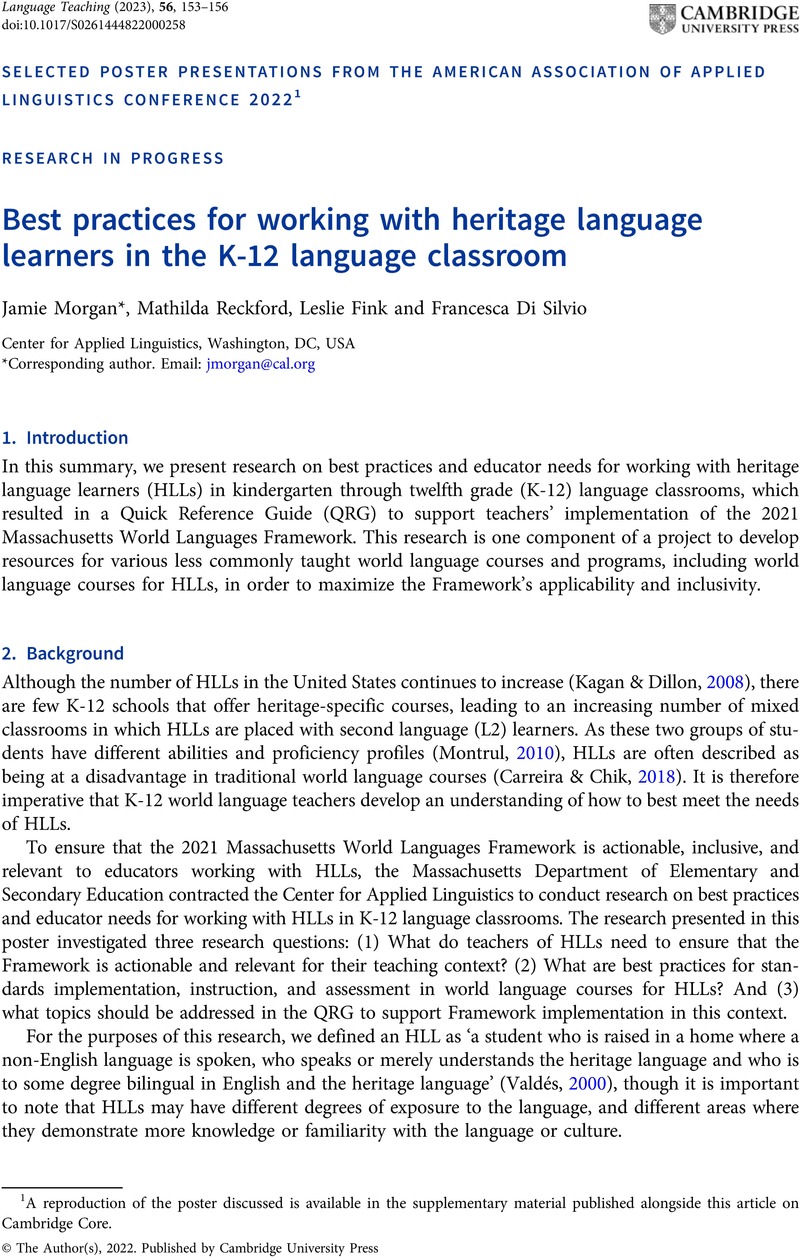No CrossRef data available.
Article contents
Best practices for working with heritage language learners in the K-12 language classroom
Published online by Cambridge University Press: 15 July 2022
Abstract
An abstract is not available for this content so a preview has been provided. Please use the Get access link above for information on how to access this content.

- Type
- Research in Progress
- Information
- Copyright
- Copyright © The Author(s), 2022. Published by Cambridge University Press
Footnotes
1
A reproduction of the poster discussed is available in the supplementary material published alongside this article on Cambridge Core.
References
Albirini, A. (2014). The role of the colloquial varieties in the acquisition of the standard variety: The case of Arabic heritage speakers. Foreign Language Annals, 47(3), 447–463. doi:10.1111/flan.12087CrossRefGoogle Scholar
Beaudrie, S., Amezcua, A., & Loza, S. (2020). Critical language awareness in the heritage language classroom: Design, implementation, and evaluation of a curricular intervention. International Multilingual Research Journal, 15 (1), 61–81. doi: 10.1080/19313152.2020.1753931Google Scholar
Burgo, C. (2017). Meeting student needs: Integrating Spanish heritage language learners into the second language classroom. Hispania, 100(5), 45–50. doi:10.1353/hpn.2018.0009CrossRefGoogle Scholar
Carreira, M., & Chik, C. H. (2018). Differentiated teaching: A primer for heritage and mixed classes. In Potowski, K. (Ed.), The Routledge handbook of Spanish as a heritage language (pp. 359–374). Routledge.CrossRefGoogle Scholar
Carreira, M., & Kagan, O. (2018). Heritage language education: A proposal for the next 50 years. Foreign Language Annals, 51(1), 152–168. doi:10.1111/flan.12331CrossRefGoogle Scholar
Chevalier, J. F. (2004). Heritage language literacy: Theory and practice. Heritage Language Journal, 2(1), 1–19. doi:10.46538/hlj.2.1.2CrossRefGoogle Scholar
Correa, M. (2011). Advocating for critical pedagogical approaches to teaching Spanish as a heritage language: Some considerations. Foreign Language Annals, 44(2), 308–320. doi:10.1111/j.1944-9720.2011.01132.xCrossRefGoogle Scholar
Douglas, M. (2005). Pedagogical theories and approaches to teach young learners of Japanese as a heritage language. Heritage Language Journal, 3(1), 60–82. doi:10.46538/hlj.3.1.3CrossRefGoogle Scholar
Kagan, O., & Dillon, K. (2008). Issues in heritage language learning in the United States. In Deusen-Scholl, N. V., & Hornberger, N. (Eds.), Encyclopedia of language and education, Volume 4: Second and foreign language education (pp. 143–156). Springer.Google Scholar
Martinez, G. (2016). Goals and beyond in heritage language education. In Fairclough, M., & Beaudrie, S. (Eds.), Innovative strategies for heritage language teaching: A practical guide for the classroom (pp. 39–55). Georgetown University Press.Google Scholar
Montrul, S. (2010). Current issues in heritage language acquisition. Annual Review of Applied Linguistics, 30, 3–23. doi:10.1017/S0267190510000103CrossRefGoogle Scholar
Parra, M. L. (2014). Strengthening our teacher community: Consolidating a ‘signature pedagogy’ for the teaching of Spanish as a heritage language. In Trifonnas, P., & Aravossitas, T. (Eds.), Rethinking heritage language education (pp. 213–236). Cambridge University Press.Google Scholar
Valdés, G. (2000). Teaching heritage languages: An introduction for slavic language-teaching professionals. In Kagan, O. (Ed.), Learning and teaching of Slavic languages and cultures: Toward the 21st century (pp. 375–403). Slavica.Google Scholar



